Electrical and Mathematical Modeling of Supercapacitors: Comparison
Abstract
:1. Introduction
2. Modelling of Supercapacitors
2.1. RC Model of the Supercapacitor
2.2. Two-Branch Model of SCs
- -
- A leakage resistance;
- -
- -
- The first cell is the fast branch, which takes into account the charging phases instead of a propagation system. It models this phase by a resistance R1 and a non-linear capacitance C1 (no phenomenon of propagation of charges).
- -
- The second cell is the slow branch that represents the redistribution phase of the charges during the rest phase. This phase is modelled by an R2–C2 branch with larger time constants than those taken for the fast phase.
2.3. Multi-Branch Model of SC
- -
- An access resistor R1 for to the transmission line;
- -
- A non-linear transmission line of n branches in parallel, a total resistance R and a total capacitance C for a fine description of the electrical and energetic behaviours of SCs in short times;
- -
- Some RC cells to apprehend the longer times.
- -
- Complementary branches with capacitances Cm and resistances Rm, which will be identified by means of a constant-current partial-charge test, and phases of internal redistribution of energy.
3. Comparison of the Different Models of the SC
3.1. Parameters of Different Models
- RC model of the constructor:
- Parameters of the two-branch model
- Parameters of the multi-branch model
- Parameters of the Belhachemi experimental model
- -
- The access resistance is R1 = 0.5 mΩ;
- -
- The total resistance R = 1.4 mΩ;
- -
- The resistance of the first complementary branch R2 = 100 mΩ;
- -
- The resistance of the second complementary branch R3 = 100 mΩ.
3.2. Simulation and Validation of the Different Models of the SC
3.3. Calculation of the Error between Different Models of the SC
3.4. Influence of the Charge Current on the Voltage
4. Conclusions
Author Contributions
Funding
Institutional Review Board Statement
Informed Consent Statement
Acknowledgments
Conflicts of Interest
References
- Liu, X.; Zhao, J.; Cao, Y.; Li, W.; Sun, Y.; Lu, J.; Men, Y.; Hu, J. Facile synthesis of 3D flower-like porous NiO architectures with an excellent capacitance performance. RSC Adv. 2015, 5, 47506–47510. [Google Scholar] [CrossRef]
- Nana, H.; Hu, X.; Tian, H. Recent advances in perovskite oxides for anion-intercalation supercapacitor. Mater. Sci. Semicond. Processing 2019, 94, 35–50. [Google Scholar] [CrossRef]
- Sharma, K.; Arora, A.; Tripathi, S.K. Review of supercapacitors: Materials and devices. J. Energy Storage 2019, 21, 801–825. [Google Scholar]
- Fares, A.M.; Kippke, M.; Rashed, M.; Klumpner, C.; Bozhko, S. Development of a Smart Supercapacitor Energy Storage System for Aircraft Electric Power Systems. Energies 2021, 14, 8056. [Google Scholar] [CrossRef]
- Barić, T.; Glavaš, H.; Barukčić, M. Impact of balance resistor uncertainty on voltages across supercapacitors. J. Energy Storage 2019, 22, 131–136. [Google Scholar] [CrossRef]
- Beguin, F.; Frackowiak, E.; Lu, M. Supercapacitors: Materials, Systems, and Applications, 1st ed.; Wiley: Hoboken, NJ, USA, 2013. [Google Scholar]
- Yu, A.; Chabot, V.; Zhang, J. Electrochemical Supercapacitors for Energy Storage and Delivery: Fundamentals and Applications (Electrochemical Energy Storage and Conversion), 1st ed.; CRC Press: Boca Raton, FL, USA, 2013. [Google Scholar]
- Miller, J.M. Ultracapacitor Applications; The Institution of Engineering and Technology: London, UK, 2011. [Google Scholar]
- Conway, B.E. Electrochemical Supercapacitors; Kluwer Academic/Plenum Publishers: New York, NY, USA, 1999. [Google Scholar]
- Cheng, X.; Zhang, D.; Liu, X.; Cao, D.; Wang, G. Influence of CTAB on morphology, structure, and supercapacitance of β-Ni (OH)2. Ionics 2015, 12, 533–540. [Google Scholar] [CrossRef]
- Cabrane, Z.; Ouassaid, M.; Maaroufi, M. Battery and Supercapacitor for Photovoltaic Energy Storage: A Fuzzy Logic Management. IET Renew. Power Gener. (RPG) J. 2017, 11, 1157–1165. [Google Scholar] [CrossRef]
- Logerais, P.O.; Camara, M.A.; Riou, O.; Djellad, A.; Omeiri, A.; Delaleux, F.; Durastanti, J.F. Modeling of a supercapacitor with a multibranch circuit. Int. J. Hydrogen Energy 2015, 40, 13725–13736. [Google Scholar] [CrossRef]
- Ayad, M.Y.; Becherif, M.; Henni, A. Vehicle hybridization with fuel cell, supercapacitors and batteries. Renew. Energy 2011, 36, 2627. [Google Scholar] [CrossRef]
- Marie-Francoise, J.N.; Gualous, H.; Outbib, R.; Berthon, A. 42V power net with supercapacitor and battery for automotive applications. J. Power Sources 2005, 143, 275. [Google Scholar] [CrossRef]
- Zhou, H.; Bhattacharya, T.; Tran, D.; Siew, T.S.T.; Khambadkone, A.M. Composite energy storage system involving battery and ultracapacitor with dynamic energy management in microgrid applications. IEEE Trans. Power Electron 2011, 3, 923–930. [Google Scholar] [CrossRef]
- Yang, H. A Review of Supercapacitor-Based Energy Storage Systems for Microgrid Applications. In Proceedings of the 2018 IEEE Power and Energy Society General Meeting (PESGM 2018), Portland, OR, USA, 5–9 August 2018; pp. 1–5. [Google Scholar]
- Yoo, H.; Sul, S.; Park, Y.; Jeong, J. System integration and power-flow management for a series hybrid electric vehicle using supercapacitors and batteries. IEEE Trans. Ind. Appl. 2008, 44, 108–114. [Google Scholar] [CrossRef]
- Herrera, V.I.; Gaztanaga, H.; Milo, A.; Ibarra, A.S.; Etxeberria-Otadui, I.; Nieva, T. Optimal energy management and sizing of a battery-supercapacitor-based light rail vehicle with a multiobjective approach. IEEE Trans. Ind. Appl. 2016, 52, 3367–3377. [Google Scholar] [CrossRef]
- Kouchachvili, L.; Yaici, W.; Entchev, E. Hybrid battery/supercapacitor energy storage system for the electric vehicles. J. Power Sources 2018, 374, 237–248. [Google Scholar] [CrossRef]
- Cabrane, Z.; Ouassaid, M.; Maaroufi, M. Performance Enhancement of Solar Vehicle by Integration of Supercapacitors in the Energy Storage System. In Proceedings of the 2014 International Renewable and Sustainable Energy Conference, Ouarzazate, Morocco, 17–19 October 2014. [Google Scholar]
- Cabrane, Z.; Batool, D.; Kim, J.H.; Yoo, K. Design and simulation studies of battery-supercapacitor hybrid energy storage system for improved performances of traction system of solar vehicle. J. Energy Storage 2020, 32, 101943. [Google Scholar] [CrossRef]
- Lahyani, A.; Venet, P.; Guermazi, A.; Troudi, A. Battery/supercapacitors combination in uninterruptible power supply (UPS). IEEE Trans. Power Electron 2013, 28, 1509–1522. [Google Scholar] [CrossRef]
- Cabrane, Z.; Kim, J.H.; Yoo, K.; Ouassaid, M. HESS-based photovoltaic/batteries/supercapacitors: Energy management strategy and DC bus voltage stabilization. Sol. Energy 2021, 216, 551–563. [Google Scholar] [CrossRef]
- Yang, H.; Zhang, Y. A task scheduling algorithm based on supercapacitor charge redistribution and energy harvesting for wireless sensor nodes. J. Energy Storage 2016, 6, 186–194. [Google Scholar] [CrossRef]
- Yang, H.; Zhang, Y. Power Management in Supercapacitor-Based Wireless Sensor Nodes, Supercapacitor Design and Applications; InTech: London, UK, 2016; pp. 165–179. [Google Scholar]
- Long, Q.; Celna, A.; Das, K.; Sørensen, P. Fast Frequency Support from Hybrid Wind Power Plants Using Supercapacitors. Energies 2021, 14, 3495. [Google Scholar] [CrossRef]
- Bose, S.; Kuila, T.; Mishra, A.K.; Rajasekar, R.; Kim, N.H.; Lee, J.H. Carbon-based nanostructured materials and their composites as supercapacitor electrodes. J. Mater. Chem. 2012, 3, 767–784. [Google Scholar] [CrossRef]
- Snook, G.A.; Kao, P.; Best, A.S. Conducting-polymer-based supercapacitor devices and electrodes. J. Power Sources 2011, 196, 1–12. [Google Scholar] [CrossRef]
- Yuan, C.; Yang, L.; Hou, L.; Shen, L.; Zhang, X.; Lou, X.W. Growth of ultrathin mesoporous Co3O4 nanosheet arrays on Ni foam for high-performance electrochemical capacitors. Energy Environ. Sci. 2012, 5, 7883–7887. [Google Scholar] [CrossRef]
- Nelms, R.M.; Cahela, D.R.; Tatarchuk, B.J. Modeling double-layer capacitor behavior using ladder circuits. IEEE Trans. Aerosp. Electron. Syst. 2003, 39, 430–438. [Google Scholar] [CrossRef]
- Lahyani, A.; Sari, A.; Lahbib, I.; Venet, P. Optimal hybridization and amortized cost study of battery/supercapacitors system under pulsed loads. J. Energy Storage 2016, 6, 222–231. [Google Scholar] [CrossRef]
- Negroiu, R.; Svasta, P.; Vasile, A.; Ionescu, C.; Marghescu, C. Comparison between Zubieta model of supercapacitors and their real behavior. In Proceedings of the 2016 IEEE 22nd International Symposium for Design and Technology in Electronic Packaging, SIITME 2016, Oradea, Romania, 20–23 October 2016; pp. 196–199. [Google Scholar]
- Lai, J.S.; Levy, S.; Rose, M.F. High energy density double-layer capacitors for energy storage applications. IEEE Aerosp. Electron. Syst. Mag. 1992, 7, 14–19. [Google Scholar] [CrossRef]
- Zhao, Y.; Xie, W.; Fang, Z.; Liu, S. A Parameters Identification Method of the Equivalent Circuit Model of the Supercapacitor Cell Module Based on Segmentation Optimization. IEEE Access 2020, 8, 92895–92906. [Google Scholar] [CrossRef]
- Cabrane, Z.; Ouassaid, M.; Maaroufi, M. Integration of supercapacitor in photovoltaic energy storage: Modelling and control. In Proceedings of the 2014 International Renewable and Sustainable Energy Conference, Ouarzazate, Morocco, 17–19 October 2014. [Google Scholar]
- Belachemi, F. Modeling and Characterization of Electric Double-Layer Supercapacitors Used in Power Electronic. Thesis, Electrical Engineering, L’Institut National Polytechnique de Lorraine, France, 2000. [Google Scholar]
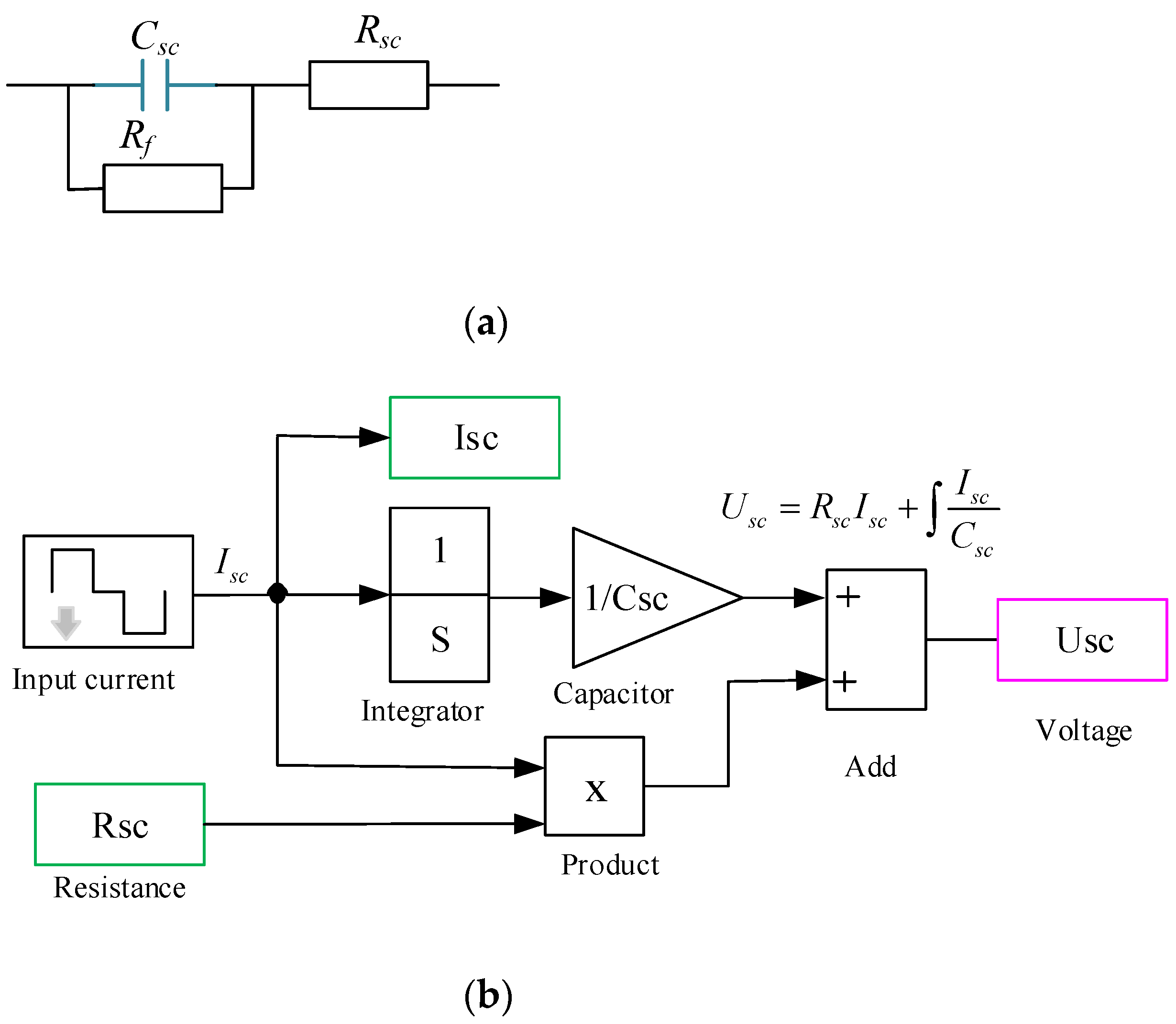
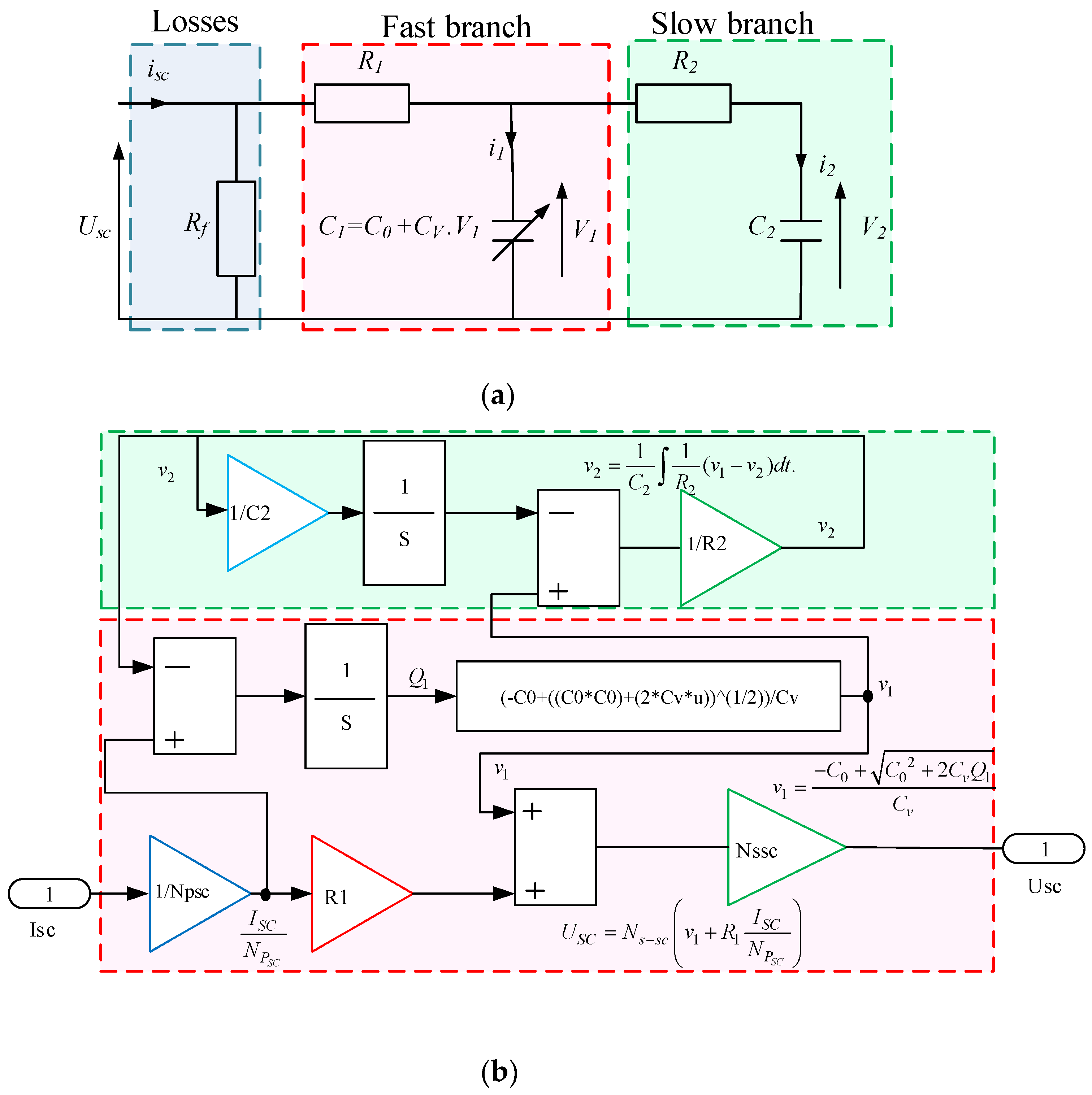
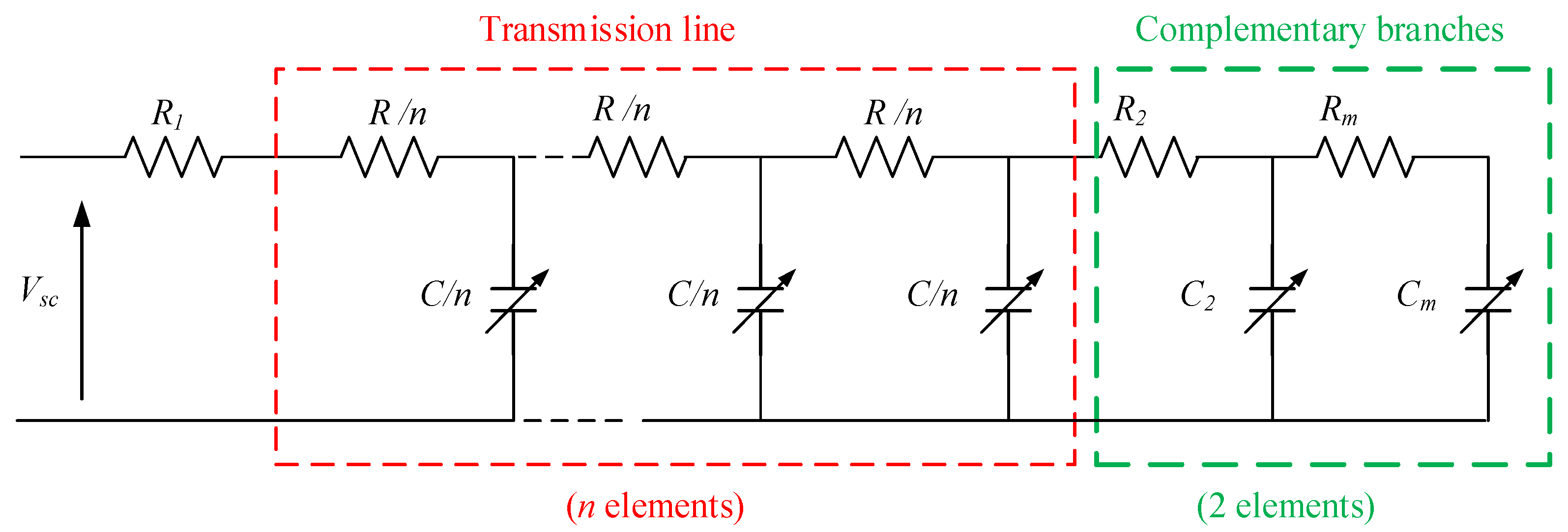
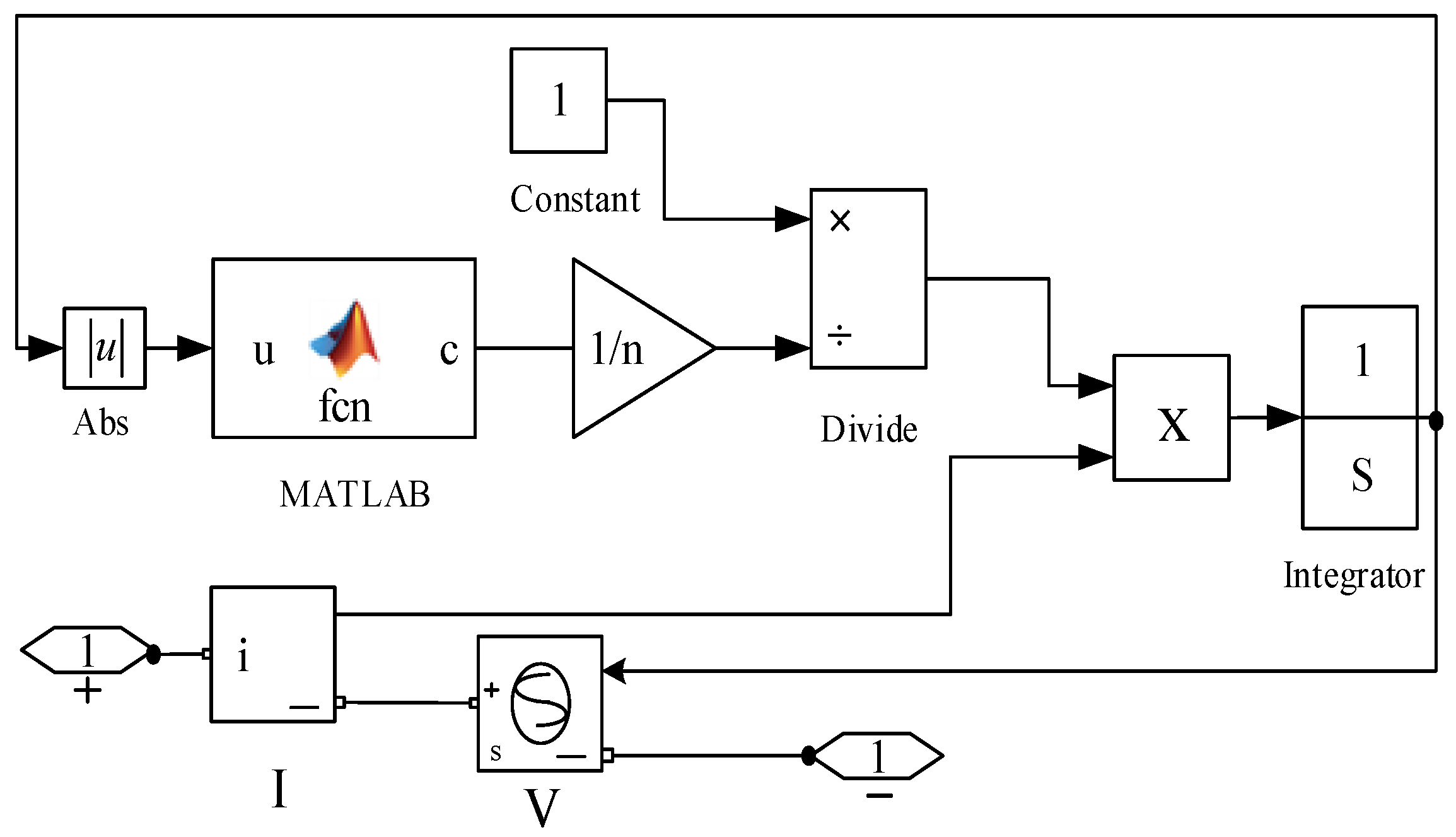
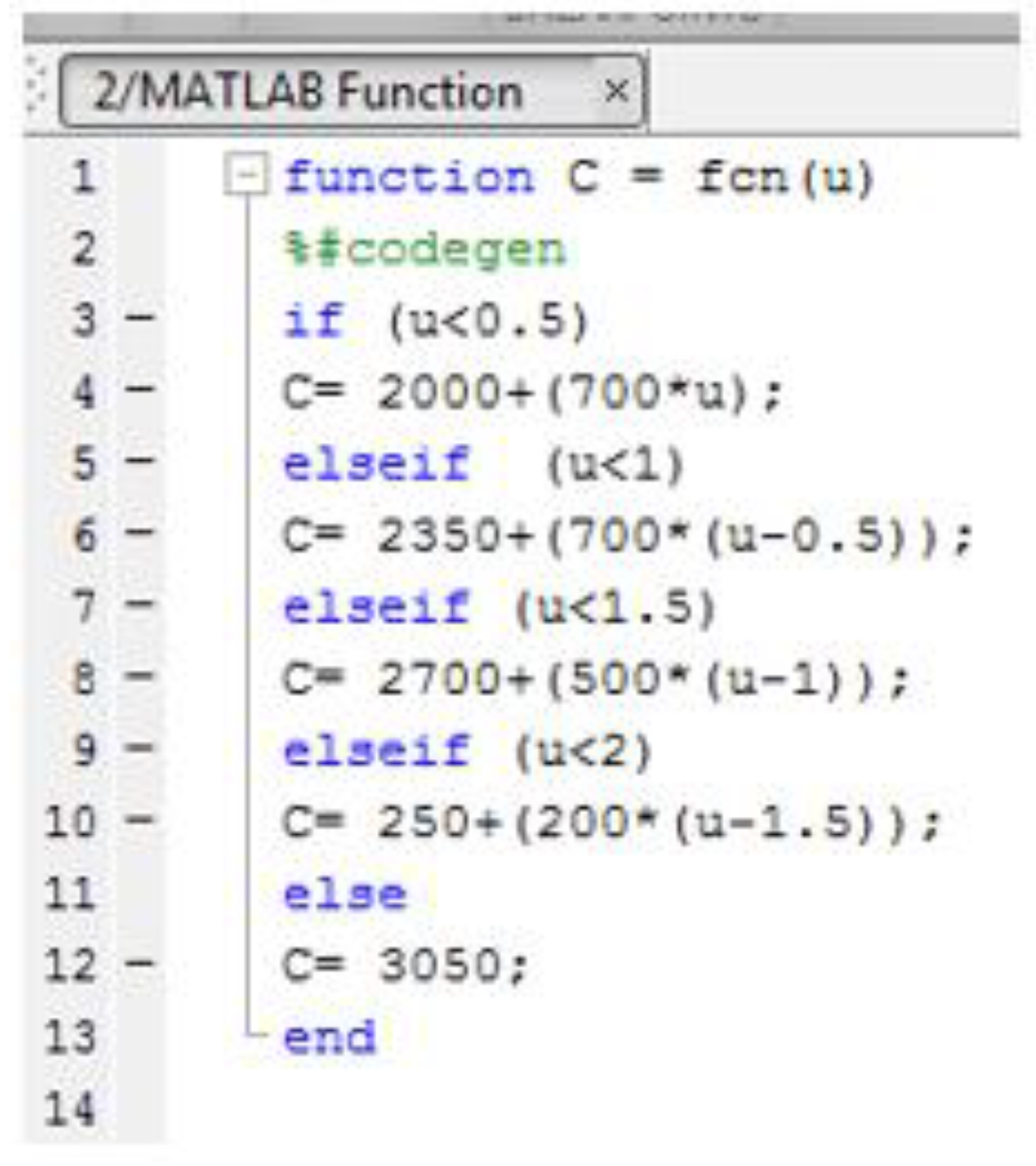
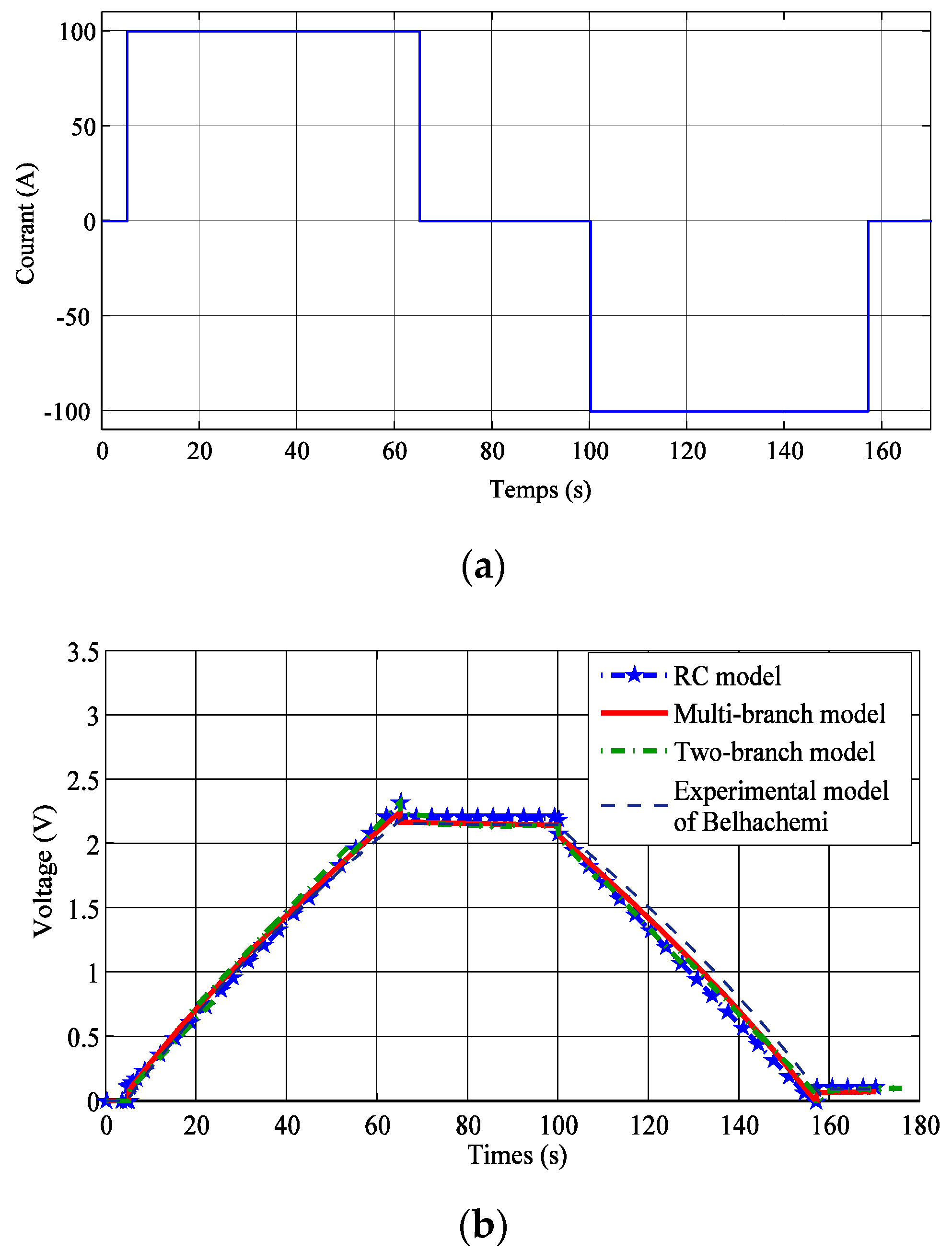
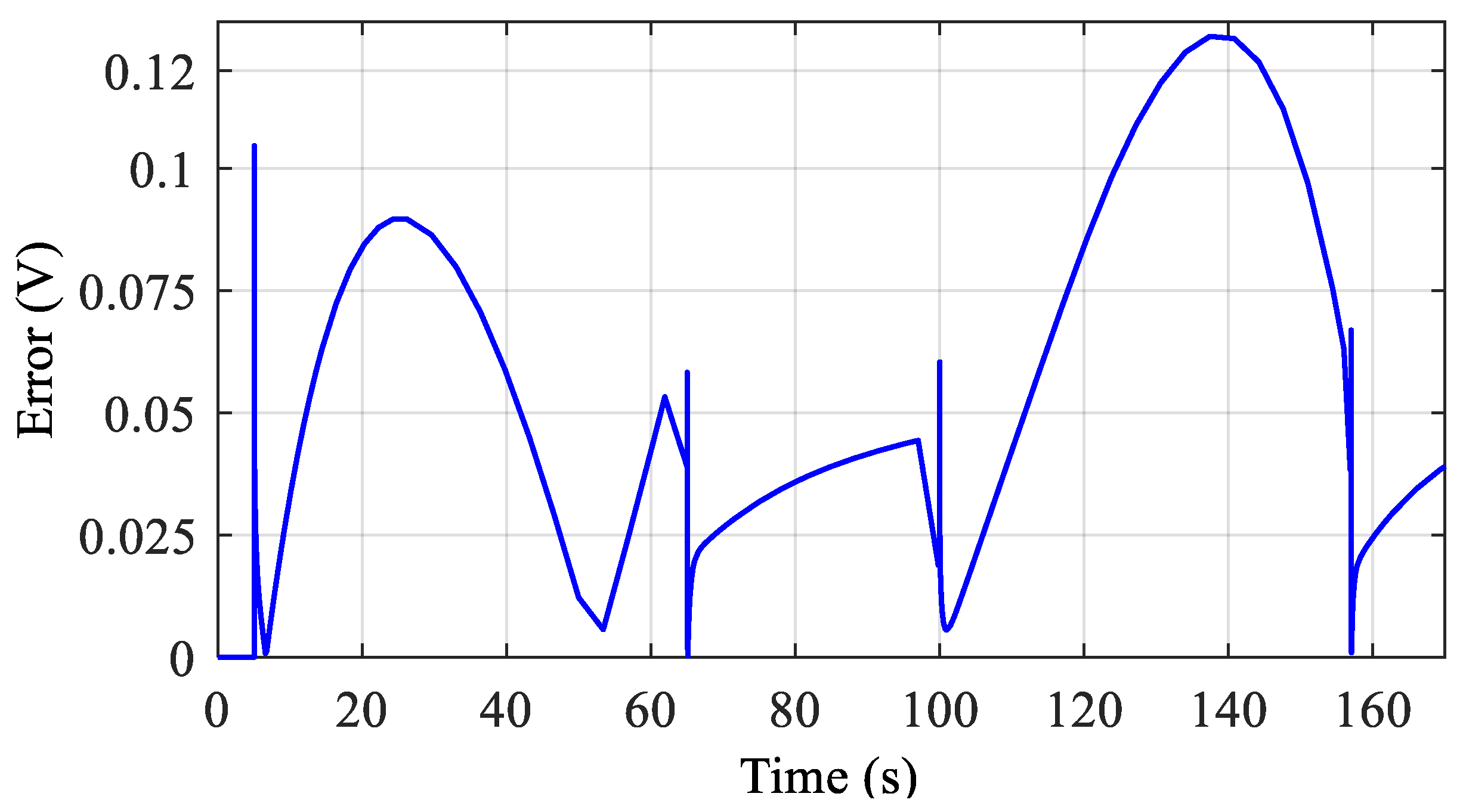
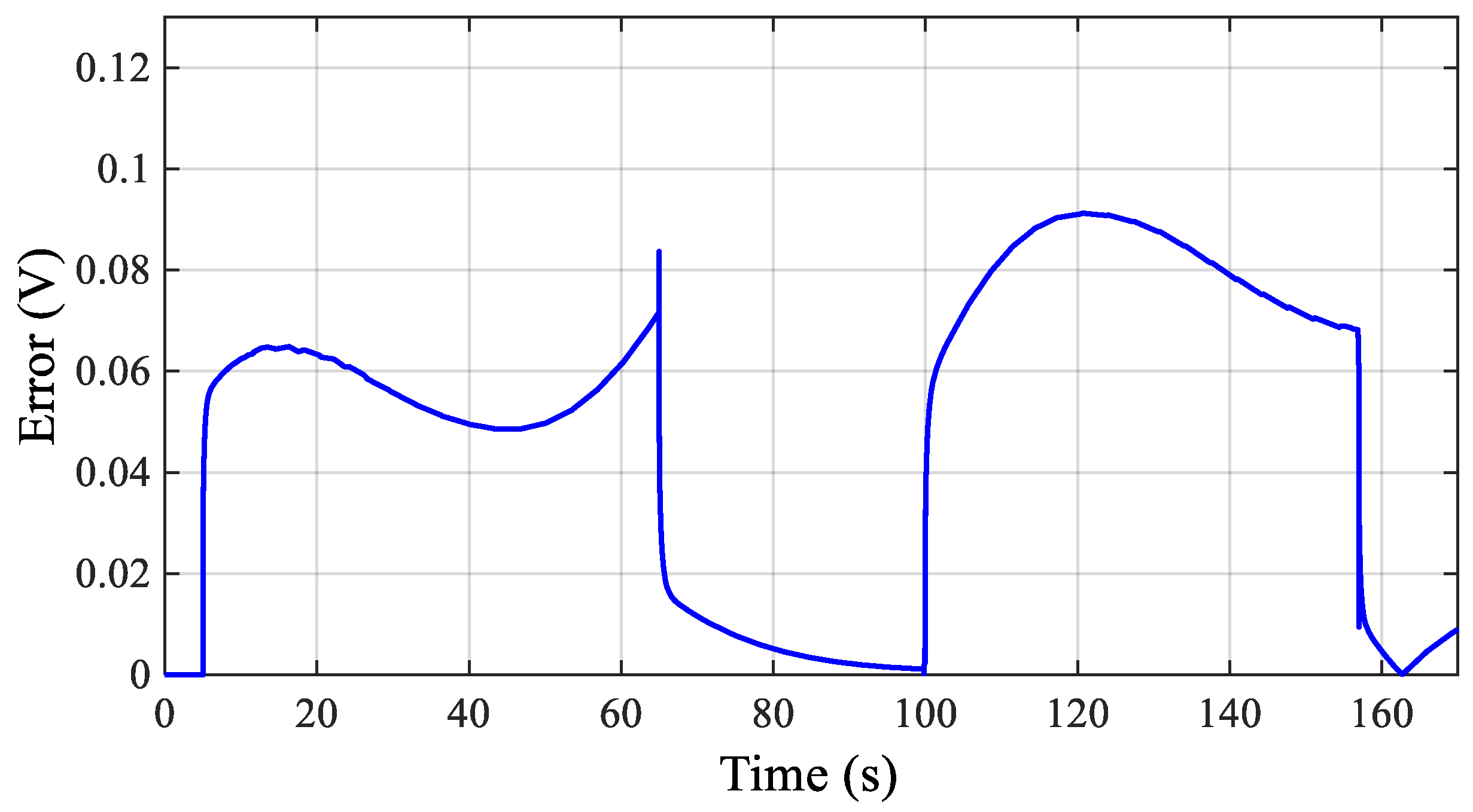
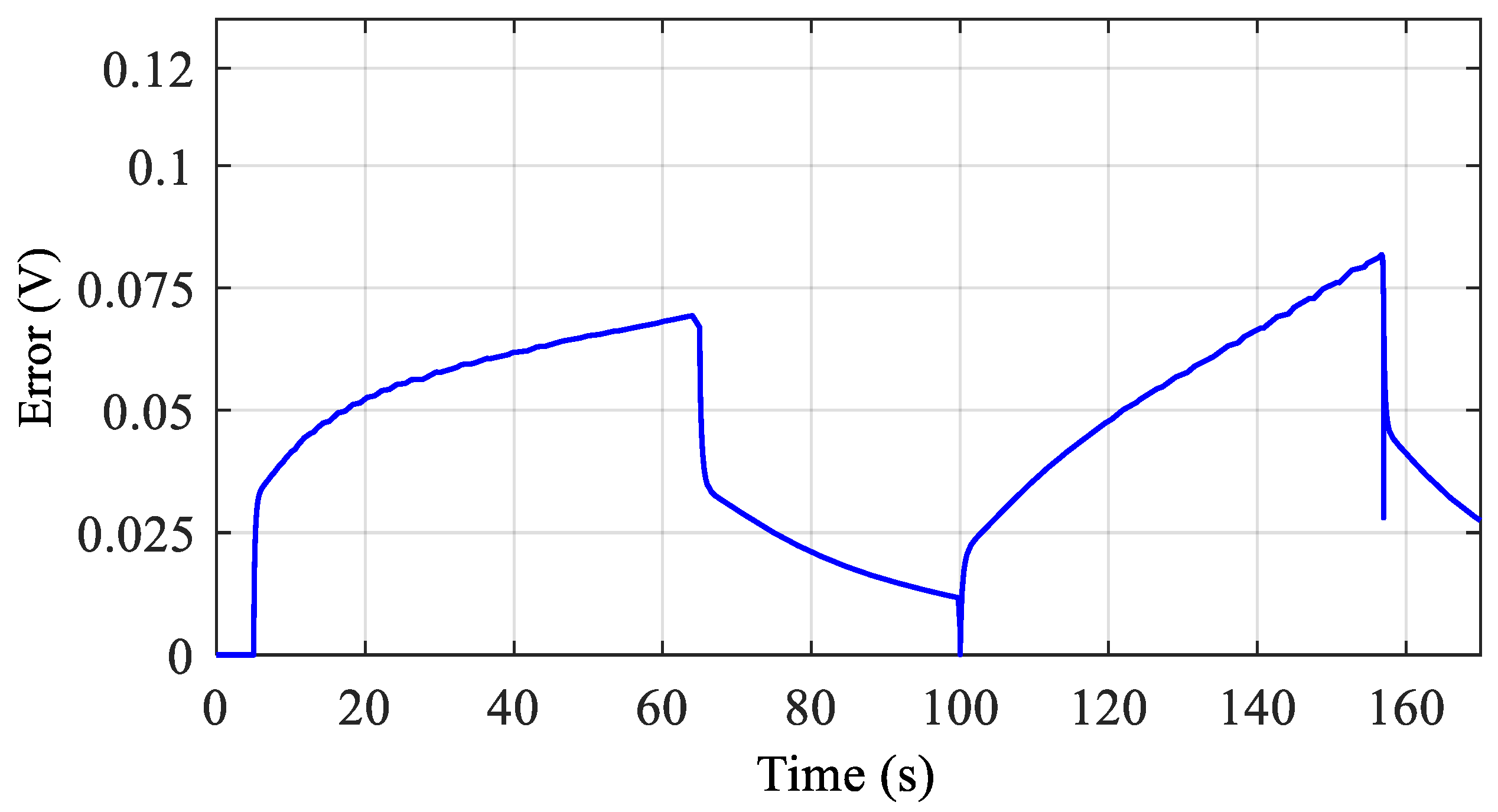
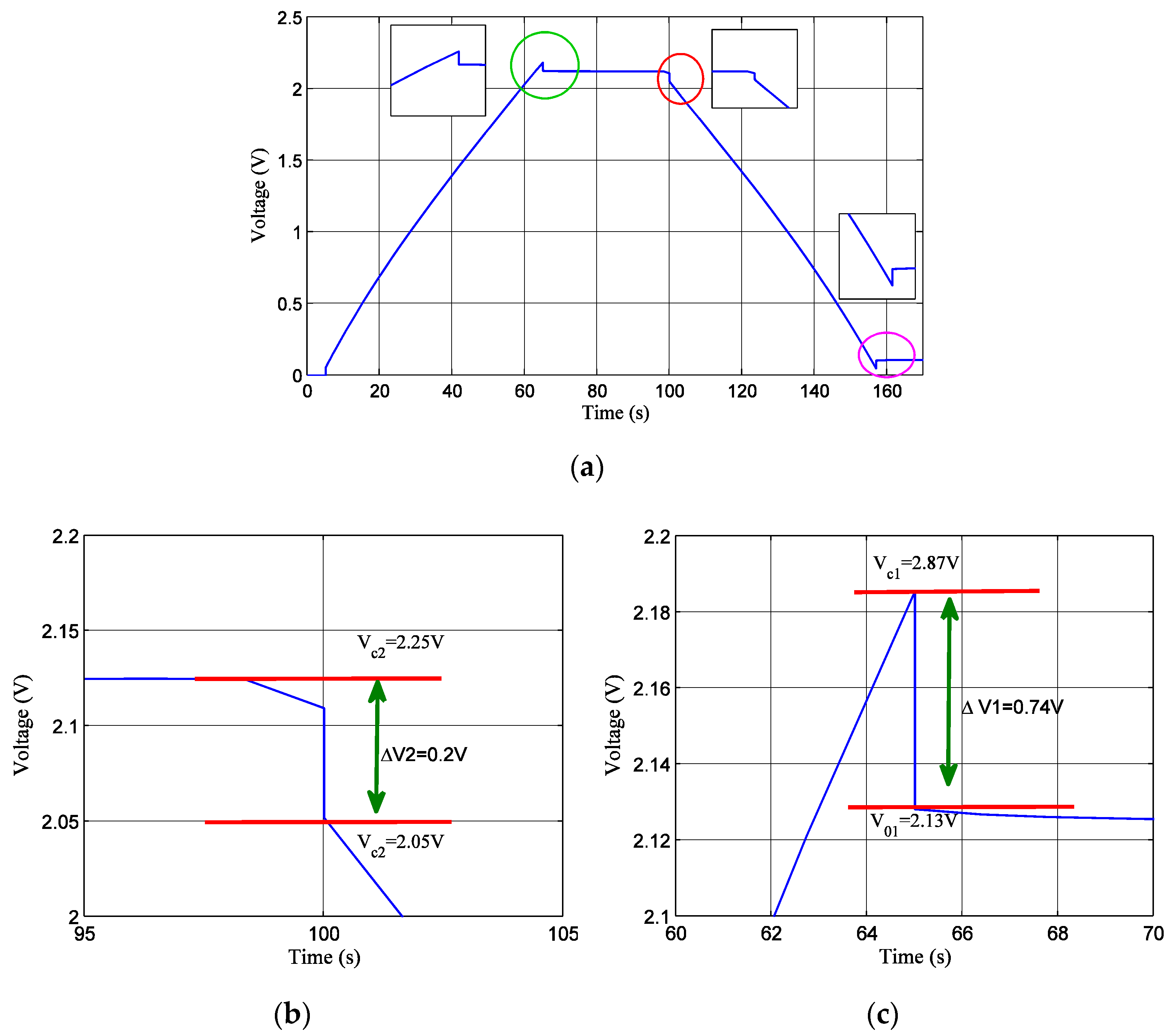
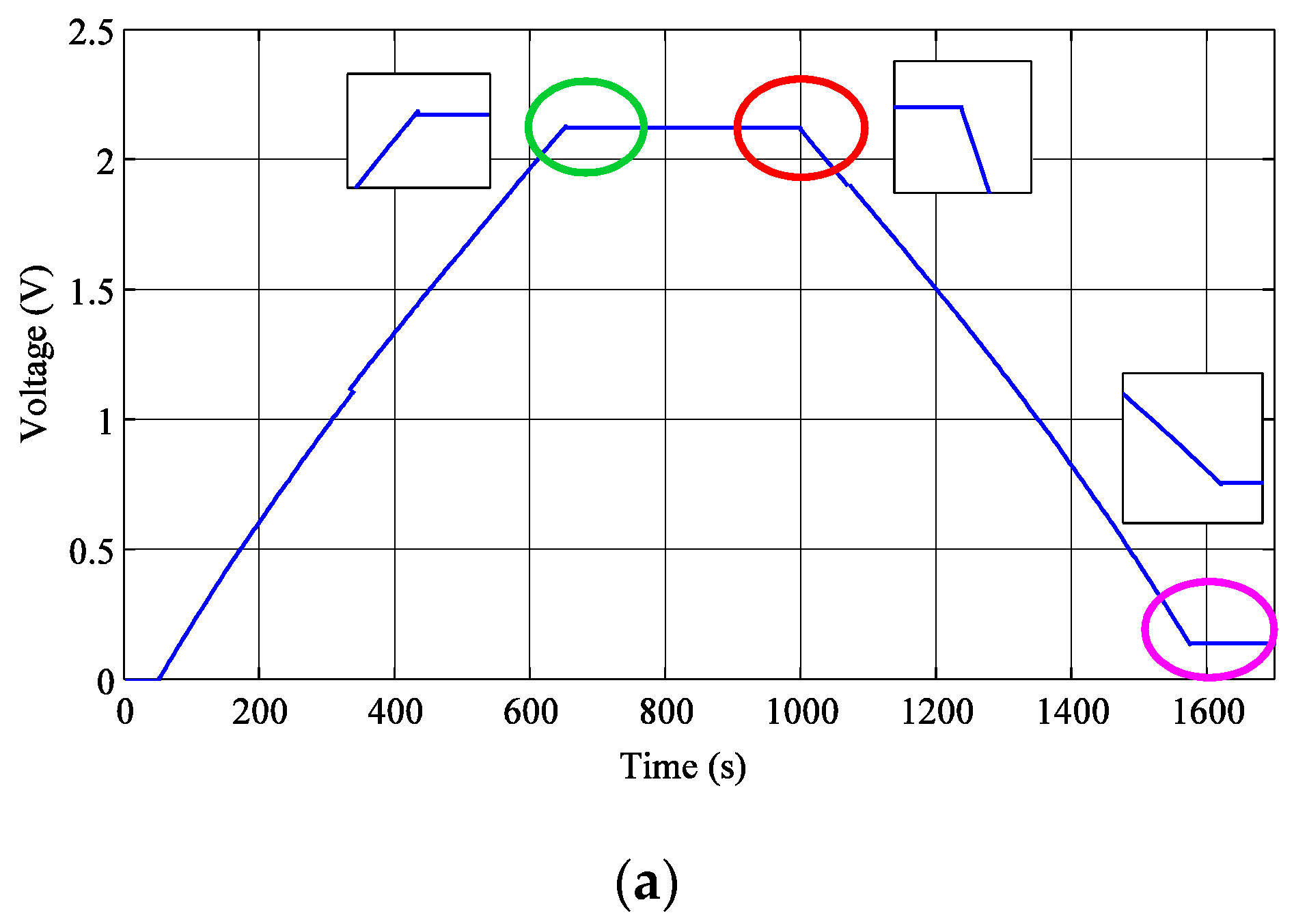
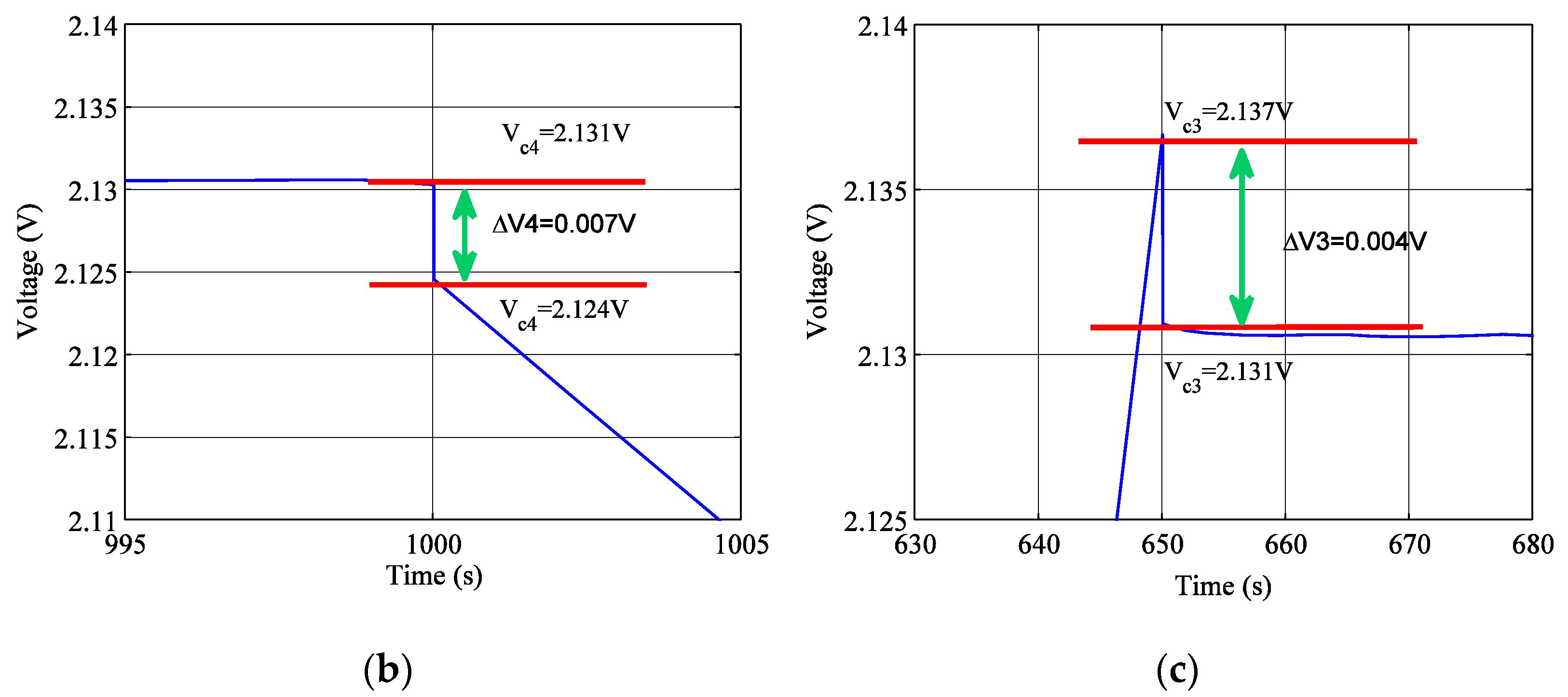
| Parameters | Values |
|---|---|
| R1 | 0.8 mΩ |
| C0 | 2170 F |
| Cv | 520 F/V |
| R2 | 1 Ω |
| C2 | 150 F |
| Voltage (V) | Transmission Line R = 1.1 mΩ | Branch R2C2 R2 = 100 mΩ | Branch R3C3 R3 = 1 Ω |
|---|---|---|---|
| Capacity C (F) | Capacity C2 (F) | Capacity C3 (F) | |
| 0 V, 0.5 V | C = 2000 + 700 v | C2 = 90 + 30 v | C3 = 31 + 11 v |
| 0.5 V, 1 V | C = 2350 + 700 (v − 0.5) | C2 = 105 + 30 (v − 0.5) | C3 = 36.5 + 30 (v − 0.5) |
| 1 V, 1.5 V | C = 2700 + 500 (v − 1) | C2 = 120 + 22 (v − 1) | C3 = 42 + 8 (v − 1) |
| 1.5 V, 2 V | C = 2950 + 200 (v − 1.5) | C2 = 131 + 5 (v − 1.5) | C3 = 46 + 3 (v − 1.5) |
| v > 2 V | C = 3050 | C2 = 133.5 | C3 = 51 |
| Voltage (in V) | The Capacity of the Transmission Line | First Complementary Branch | Second Complementary Branch |
|---|---|---|---|
| 0 | 2000 | 90 | 31 |
| 0.5 | 2350 | 105 | 36.5 |
| 1 | 2700 | 120 | 42 |
| 1.5 | 2950 | 131 | 46 |
| 2 | 3050 | 133.5 | 51 |
| 2.5 | 3050 | 133.5 | 51 |
Publisher’s Note: MDPI stays neutral with regard to jurisdictional claims in published maps and institutional affiliations. |
© 2022 by the authors. Licensee MDPI, Basel, Switzerland. This article is an open access article distributed under the terms and conditions of the Creative Commons Attribution (CC BY) license (https://creativecommons.org/licenses/by/4.0/).
Share and Cite
Cabrane, Z.; Lee, S.H. Electrical and Mathematical Modeling of Supercapacitors: Comparison. Energies 2022, 15, 693. https://doi.org/10.3390/en15030693
Cabrane Z, Lee SH. Electrical and Mathematical Modeling of Supercapacitors: Comparison. Energies. 2022; 15(3):693. https://doi.org/10.3390/en15030693
Chicago/Turabian StyleCabrane, Zineb, and Soo Hyoung Lee. 2022. "Electrical and Mathematical Modeling of Supercapacitors: Comparison" Energies 15, no. 3: 693. https://doi.org/10.3390/en15030693
APA StyleCabrane, Z., & Lee, S. H. (2022). Electrical and Mathematical Modeling of Supercapacitors: Comparison. Energies, 15(3), 693. https://doi.org/10.3390/en15030693






